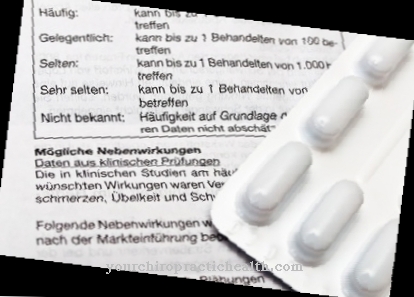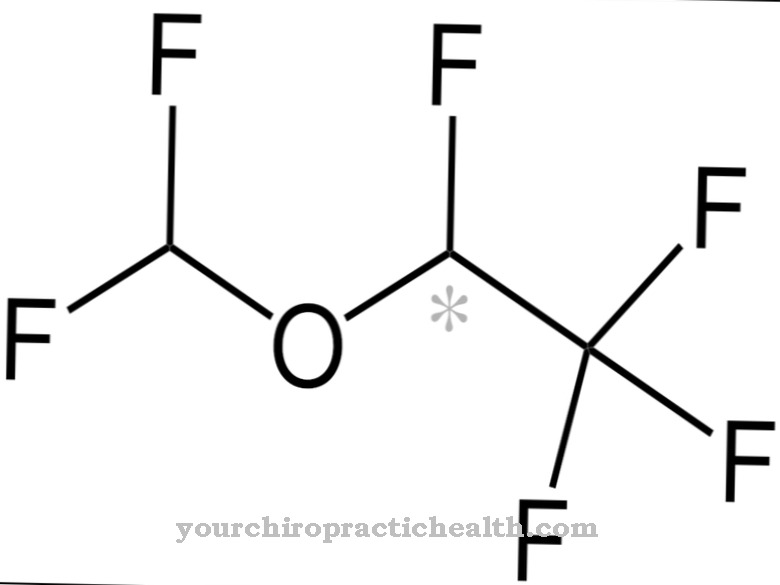The active substance Famotidine belongs to the H2 antihistamines.It is used to treat gastric diseases and reduces gastric acid secretion.
What is famotidine?
Famotidine is an H2 antihistamine. It is offered in Germany in the form of film-coated tablets and is in circulation as a generic from various suppliers. Famotidine can be used to control gastric acid production as part of gastric ulcer prophylaxis.
The drug is also suitable for treating reflux disease. Together with antacid medications, famotidine also helps against acid regurgitation and heartburn.
Pharmacological effect

Famotidine is an H2 receptor blocker. These active ingredients have the property of reducing the excessive production of stomach acid. In this way, pain can be effectively relieved for both gastric ulcers and duodenal ulcers. In addition, famotidine has a positive effect on the healing process of the ulcer.
In medicine, famotidine is one of the most efficient drugs of its kind. Even in small doses, the antihistamine can counteract the activity of the stomach cells. These cells produce gastric acid (hydrochloric acid). Famotidine is able to slow down the production of gastric juice, which reduces unwanted irritation of the ulcers.
The bioavailability of famotidine is between 20 and 68 percent. In the blood, the agent is on average 20 percent bound to plasma proteins. About 30 percent of the metabolism takes place via the kidneys. The plasma half-life usually reaches three hours.
Medical application & use
Famotidine is used to treat benign gastric ulcers (ulcera ventriculi) and duodenal ulcers (ulcera duodeni). Another indication is the so-called Zollinger-Ellison syndrome. This disease leads to the formation of ulcers in the stomach, the duodenum and the jejunum. In this condition, too, the production of gastric acid increases pathologically. With other drugs, famotidine can also be used to treat heartburn and acid regurgitation.
Famotidine is administered in the form of film-coated tablets. The dosage of the drug depends on the type of disease. In the case of benign gastric ulcers or acute duodenal ulcers, two film-coated tablets in an amount of 20 grams per day are taken in the evening hours. Alternatively, one 40 milligram tablet a day can be administered.
In Zollinger-Ellison syndrome, the patient is given a 20 mg film-coated tablet every six hours, unless they have been pretreated with anti-secretion preparations. The extent of gastric acid secretion and how the patient responds clinically to the agent plays an important role in the dosage. Sometimes daily doses of up to 800 milligrams can be taken with famotidine over a period of one year without any increased side effects.
Because famotidine is largely eliminated via the kidneys, patients with impaired kidney function should not consume more than 20 milligrams of the antihistamine. The same applies to dialysis patients.
In the case of gastric and duodenal ulcers, the recommended duration of therapy is four to eight weeks. In Zollinger-Ellison syndrome, treatment is continued for as long as medically necessary.
You can find your medication here
➔ Medication for heartburn and bloatingRisks & side effects
The administration of famotidine can cause undesirable side effects. However, they do not occur in everyone. Most patients experience constipation, diarrhea, headache, or dizziness. Occasionally there may be rashes on the skin, tiredness, nausea and vomiting.
In rare cases, joint pain, itching, pronounced skin reactions, hair loss, confusion, depression, loss of libido, erectile dysfunction and hallucinations are possible.
If the patient suffers from hypersensitivity to famotidine or another H2-receptor blocker, the drug should not be taken. Otherwise there is a risk of cross allergies. People with impaired kidney and liver function should refrain from taking the drug in high doses for long periods of time. Children under 16 years of age are generally not advised to use famotidine for heartburn or gastric acidosis because they do not have sufficient information about possible side effects in their age group.
Famotidine may only be used during pregnancy after the attending physician has carefully weighed up the risks and benefits. Famotidine also has the property of being excreted in breast milk. For this reason, disorders of the child's gastric acid production are conceivable.
Taking famotidine and other drugs at the same time can cause disruptive interactions. For example, the absorption of the antifungal drugs itraconazole and ketoconazole into the bloodstream is reduced. In contrast, the effect of erythromycin, which is one of the antibiotics, increases. If famotidine is taken in parallel with an acid-binding agent such as sucralfate, this leads to a reduced absorption of the H2 antihistamine. When combined with the gout drug probenecid, the excretion of famotidine is slower.













.jpg)

.jpg)
.jpg)











.jpg)